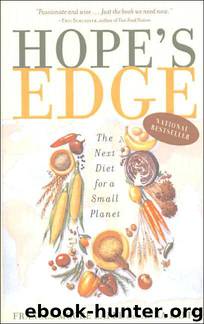Hope's Edge: The Next Diet for a Small Planet by Frances Moore Lappé; Anna Lappé

Author:Frances Moore Lappé; Anna Lappé
Language: eng
Format: mobi, epub, pdf
Tags: Globalization - Social Aspects, Economics, Environmental Ethics, Capitalism - Social Aspects, Nature, Vegetarian Cookery, Healthy Living, Vegetarian, Philosophy, General, Diets, Globalization, Ecology, Social Aspects, Political Science, Health & Fitness, Capitalism, Cooking, Ethics & Moral Philosophy, Business & Economics
ISBN: 9781585422371
Publisher: Jeremy P. Tarcher/Putnam
Published: 2003-07-15T10:00:00+00:00
10. Hypothetical All-Plant-Food Diet (Just to Prove a Point)
Clearly this diet contains much more protein, 57.7 grams, than the National Academy of Science’s recommendation of 44 grams of protein for an average American woman eating a typical American diet. But this allowance assumes that two-thirds of that protein is highly usable animal protein. Since my hypothetical daily menu contains no animal protein, and since I am trying to show that protein complementarity is not essential, let’s adjust the National Academy’s recommendation upward to what it would be for a plant food diet, assuming no protein complementarity. The allowance rises to about 55 grams. Yet my hypothetical diet still exceeds the allowance.
In the example, I used the weight and protein allowance of a typical American woman. But the same pattern would hold true for any weight person, since the protein allowance and calorie needs rise proportionately as body weight increases. For men, getting enough protein without exceeding calories limits is even a slight bit easier. (Men are allowed 2 more calories for every gram of protein than are women.)
Note that my hypothetical diet, while not intentionally protein-packed, is a healthy one. It contains few protein-empty foods, only sugar, honey, oil, an apple, and apple juice. They comprise only about 25 percent of the calories. The more of these protein-empty foods one eats, the more the rest of the diet should be filled with foods with considerable protein.
But a number of the world’s authorities on protein believe that the current recommended daily protein allowance may be too low. At the Massachusetts Institute of Technology, three-month-long experiments, with subjects consuming the recommended amount of protein in the form of egg, for most subjects resulted in the loss of lean body mass and a decrease in the proteins and oxygen-carrying cells of the blood.
If the recommended allowance were pushed up by one-third, as some scientists believe it should be, would it then be difficult to eat enough protein without meat?
The average American woman’s recommended allowance would then be 59 grams of protein. At this higher level, combining protein foods to improve the usability of the protein would become more important. But in this hypothetical day’s diet there are already complementary protein combinations (peanut butter plus bread, beans plus rice) which would bring the usability of the protein up closer to that assumed in the recommended allowance. To be totally safe, however, one might want to replace one of the protein-empty foods with an additional protein food if maintaining an all plant food diet. (For example, replacing the sugar and honey with grain or vegetable.)
Very few Americans, however, eat only plant foods. Even most vegetarians eat some dairy products. So in Figure 11 let’s look at basically the same day’s diet but this time put in two modest portions of dairy foods, one cup of skim milk and a one-inch cube of cheese. These changes bring the total protein up to 71 grams—well above even the highest standard recommended by some nutritionists.
Download
Hope's Edge: The Next Diet for a Small Planet by Frances Moore Lappé; Anna Lappé.epub
Hope's Edge: The Next Diet for a Small Planet by Frances Moore Lappé; Anna Lappé.pdf
This site does not store any files on its server. We only index and link to content provided by other sites. Please contact the content providers to delete copyright contents if any and email us, we'll remove relevant links or contents immediately.
| Non-Vegan Vegetarian | Vegan |
Dinner in an Instant by Melissa Clark(3000)
Ottolenghi - The Cookbook by Yotam Ottolenghi(2732)
Oh She Glows Every Day by Angela Liddon(2627)
Veg by Jamie Oliver(2303)
Superfood Smoothie Bowls: Delicious, Satisfying, Protein-Packed Blends that Boost Energy and Burn Fat by Chace Daniella(2232)
The Starter Garden Handbook by Alice Mary Alvrez(2193)
Wanderlust by Jeff Krasno(2141)
Eat With Intention by Cassandra Bodzak(2003)
The Main Street Vegan Academy Cookbook by Victoria Moran(1938)
QUESO! by Lisa Fain(1905)
2250 Pressure Cooker, Crock Pot, Instant Pot and Slow Cooking Recipes Cookbook: (Crock-Pot Meals, Instant Pot Cookbook, Slow Cooker, Pressure Cooker Recipes, Slow Cooking, Paleo, Vegan, Healthy) by Jamie Stewart(1885)
Eat and Run by Scott Jurek(1859)
Vegan Desserts by Hannah Kaminsky(1846)
Stuff Every Vegetarian Should Know by Katherine McGuire(1843)
Vegetarian Times Plant-Powered Protein Cookbook by Editors of Vegetarian Times(1798)
Oh She Glows for Dinner by Angela Liddon(1711)
Healing the Vegan Way : Plant-based Eating for Optimal Health and Wellness (9780738217789) by Reinfeld Mark(1699)
Alternative Vegan by Marie Reginato(1654)
Mouthwatering Vegan Burgers by Becky Lawton(1567)
